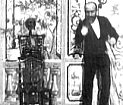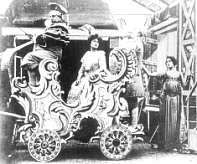

*WORK*

"I owe him everything." - D. W. Griffith
1896: 80 films
Un Partie de Cartes (A Card Party) - Melies' first film, a one-minute tableau of four men playing a card game. This was an imitation of the Lumiere film Partie d'Ecarte.
Escamotage d'Une Dame au Theatre Robert-Houdin (Conjuring of a Woman at the Theatre of Robert-Houdin - An early example of Melies' famous stop-motion illusion, in which the camera is halted in the middle of a scene to allow replacement of a prop or actor. Here a lady is turned into a skeleton.
1897: 51 films
Le Cabinet de Mephistopheles (The Labratory of Mephistopheles) - The devil often appeared in Melies' work.
1898: 36 films
La Caverne Maudite (The Cavern of Demons) - Melies' first use of what he called "spirit photography," or double exposure. Here ghosts and skeletons appear, and the walls of the cave can be seen through their bodies.
Un Homme de Tete (A Man with Heads) - A foray into decapitation, where three of Melies' heads float around the stage. The film displayed the first split-screen shots.
1899: 44 films
Cendrillon (Cinderella) - A 7-minute film with 20 scenes and a cast of over 35 people, containing the first dissolve from one shot to another.
L'Affaire Dreyfus (The Dreyfus Affair) - A ground-breaking film which reconstructed a controversial news event. It was eventually banned in France because of the uproar it caused.
1900: 41 films
L'Homme Orchestre (The Man Orchestra) - Here Melies multiplies into a seven-man band.
1901: 30 films
L'Homme a La Tete en Caoutchouc (The Man with the Rubber Head) - A scene in which Melies' giant head is pumped up to a huge size and then explodes. This illusion was accomplished not by moving the camera but by moving the actor on a track towards the camera. Had the camera been moved, Melies would have invented the dolly shot.
1902: 41 filmsLe Voyage Dans La Lune (The Voyage to the Moon) - A large-budget film lasting 14 minutes, inspired by novels by Jules Verne and H.G. Wells. This is by far the most famous of Melies' films. Here a group of explorers is rocketed to the moon (hitting the man in the moon in the eye), where they battle a group of aliens that explode when struck. The astronomers then return back to Earth where they are hailed as heroes. This movie was widely pirated and immensely popular.
1903: 30 films
La Lanterne Magique (The Magic Lantern) - A film of self-awareness, in which a "magic lantern" projects a moving picture of the clown who watches.
1904: 35 filmsLe Voyage a Travers L'Impossible (The Impossible Voyage) - In which a train full of explorers leaves the earth and is chewed up by the sun. This is a two-reel film, the longest and most complex of its time (as several of Melies' films were).
1905: 22 films
1906: 16 films
1907: 28 films
20000 Lieues Sous les Mers (20,000 Leagues Under the Sea) - An adaptation of Jules Verne's novel in which a fisherman dreams of a trip beneath the waves. This film featured creatures modeled after the book's original drawings, as well as some scenes shot through a glass tank with real fish.
1908: 59 films
1909: 13 films
1910: 12 films
1911: 1 film
1912: 3 films
La Conquete du Pole (The Conquest of the Pole) - Another fantasy in the vein of Melies' earlier work. We meet some more explorers, this time determined to visit the North Pole. They travel through the stars and make it to the North, where they find a giant (who eats a few of them). The giant was constructed as a life-size marionette.
1913: 1 film
Le Voyage de la Famille Bourrichon (Voyage of the Bourrichon Family) - Melies' last and unsuccessful film, an adaptation of a farce by Eugene Labiche.